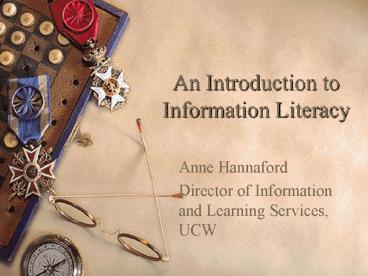An Introduction to Information Literacy - PowerPoint PPT Presentation
1 / 9
Title:
An Introduction to Information Literacy
Description:
... use the needed information American Library Association 1989 QAA Subject Benchmark for Computing recognises ... lit/papers /Seven_pillars2.pdf ... early work ... – PowerPoint PPT presentation
Number of Views:991
Avg rating:3.0/5.0
Title: An Introduction to Information Literacy
1
An Introduction to Information Literacy
- Anne Hannaford
- Director of Information and Learning Services, UCW
2
What is Information Literacy?
- An information literate person is one who is
able to recognize when information is needed and
have the ability to locate, evaluate and
effectively use the needed information
- American Library Association 1989
- Encompasses IT skills and information skills
3
QAA Subject Benchmark for Computing
- recognises importance of lifelong transferable
skills - Effective information-retrieval skills (including
the use of browsers, search engines and
catalogues). - learning in the future is likely to revolve
around the use and exploitation of electronic
material.. for the present, academics face the
challenge of how to teach this and how to assess
it.
4
Development of the concept
- Term first used in 1974
- Paul Zurkowski, Information Industry Association
(IIA), - viewed a growing need for better handling and use
of the increasing proliferation of information in
the workplace. - Recognised the need to be able to use tools as
well as information sources
5
ILit within the H.E. sector
- 1970s definitions began to emerge from
librarians and the education sector - 1980s - new information technologies began to be
recognized as an important feature of information
literacy. - mid 1980's, academic librarians began to view
user education programs in terms of information
literacy rather than information skills - 1999 SCONUL model
6
Current trends
- Move towards institutional strategies / policies
for ILit - Embedding in curricula
- Work on assessing / evaluating effectiveness
- New delivery methods e.g.VLEs
7
Models
- ACRL (USA)
- http//www.ala.org/ala/acrl/acrlstandards/informat
ionliteracycompetency.htm - detailed outcomes but does not indicate the level
of skill - SCONUL (UK)
- http//www.sconul.ac.uk/activities/inf_lit/papers/
Seven_pillars2.pdf - assumes progression through levels
8
SCONUL 7 pillars model
Information literacy
Novice Advanced beginner Competent
Proficient Expert
Distinguish ways of addressing gap
Recognise information need
Organise, apply and communicate
Locate and access
Construct strategies for locating
Compare and evaluate
Synthesise and create
Basic Library Skills
IT Skills
9
Issues in H.E.
- ILit often not recognised at institutional level
- Even if it is, confusion about what it is,
especially compared to IT skills - ILit not included in Dearing key skills
- One off sessions vs. integration into the
curriculum - web searching is easy attitude
- Belief that students will pick up skills
- Difficulties in assessing / evaluating skills
- Who delivers? status of library staff
- Webber (2002) http//dis.shef.ac.uk/literacy/tfpl
-1202-sw.ppt































